Laurel Hubbard debuted in the female category in 2017, and posted a new world record in the W35/super heavyweight category at the IWF Masters that same year. 

For this performance, she was named the best lifter in the entire female competition (all ages and weight categories). 

Her lift total of 280 kg absolutely smashed her category competitors.
It wouldn’t have been out of place in the corresponding male category.
It wouldn’t have been out of place in the corresponding male category.

In fact, Hubbard’s 2017 lift was entirely routine over ten years of the male competition, and a huge outlier in the female competition over the same ten years. 

For those asking, this first (incomplete) part of the story shows how, controlled for age, Hubbard is lifting well outside female range.
The second part is, of course, that Hubbard has earned an Olympic spot, despite her advanced age.
There will be more charts...
The second part is, of course, that Hubbard has earned an Olympic spot, despite her advanced age.
There will be more charts...
• • •
Missing some Tweet in this thread? You can try to
force a refresh







